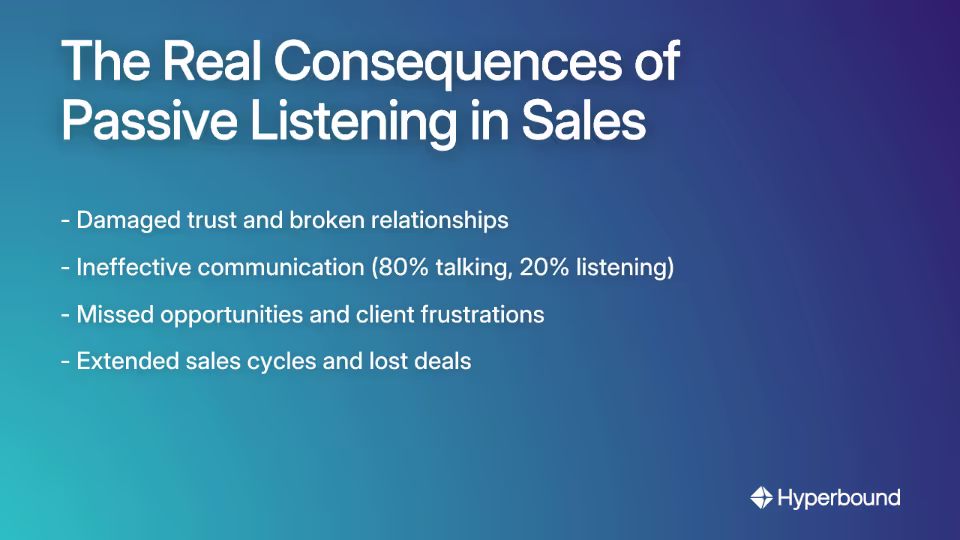.avif)
You've probably heard the age-old sales advice: "Talk less, sell more." But in practice, many sales professionals struggle with this concept. They arm themselves with polished talk tracks and compelling presentations, yet still find themselves facing resistance, confusion, and lost deals.
The missing ingredient? True active listening.
While listening is passive for many salespeople—merely waiting for their turn to speak—those who master active listening develop what appears to be an almost supernatural ability to "read minds" and close deals with remarkable efficiency.
The High Cost of Tuning Out: Why Passive Listening Kills Deals

According to the Gift of Life Institute, passive listening is listening without reacting or paying full attention to what's being said. It's simply hearing words without processing their meaning or significance.
In sales, this passive approach comes with devastating consequences:
Damaged Relationships: When clients sense you're not truly hearing them, trust evaporates. As the saying goes, "People don't care how much you know until they know how much you care." Passive listening signals that you don't.
Ineffective Communication: A study in financial services found that salespeople spoke 80% of the time during sales calls—a counterproductive habit that creates disconnect rather than connection. ([Source: SalesDrive])
Lost Opportunities: One Reddit user perfectly captured a common frustration: "If someone asks you about apples, don't start talking about oranges." Yet this happens constantly when salespeople are mentally rehearsing their next point instead of truly listening.
Extended Sales Cycles: Remember that "Time kills deals." When you miss key information due to passive listening, you'll need additional meetings to gather what you should have caught the first time.
What is Active Listening, Really? Beyond Just Hearing Words
Active listening isn't simply hearing—it's a strategic skill that involves fully concentrating, understanding, responding, and remembering what is being said.
The real issue isn't just being quiet—it's a failure to engage and understand the message, which complicates professional interactions and extends the deal cycle unnecessarily.
Active listening becomes your "mind-reading" tool because it allows you to:
- Understand the explicit needs a prospect articulates
- Uncover the implicit needs they haven't yet recognized
- Detect emotional cues that reveal their true priorities and concerns
- Identify objections before they're fully formed
The "Mindreading" Toolkit: 9 Actionable Active Listening Skills
To transform your sales approach, master these nine concrete active listening techniques:
1. Be Fully Present
Before every call or meeting, take a moment to clear your mind. As one Reddit user admitted, "I tried yet I still find myself drifting off at times." Some view this as evidence that "deep down you really don't give a shit," but another perspective is that "drifting [is] a symptom and not a lack of interest."
Combat drifting by:
- Using pen and paper to take notes (the physical act helps maintain focus)
- Removing digital distractions
- Setting a clear intention to be curious about this specific prospect
2. Ask Open-Ended Questions
Instead of questions that elicit yes/no responses, ask questions that invite elaboration. One sales professional on Reddit found success by "simply asking the hard questions nobody likes asking." (Source: Reddit)
Examples:
- "What does success look like for this initiative?"
- "How would solving this problem impact your team's performance?"
- "What concerns you most about your current solution?"
3. Summarize and Paraphrase
The ultimate proof of listening is being able to play back what you've heard in your own words. After a prospect shares information:
"So if I understand correctly, your team is struggling with [summarize their challenge], which is causing [paraphrase the impact], and ideally, you're looking for a solution that [restate their goal]. Is that right?"
This technique not only confirms understanding but makes the prospect feel truly heard.
4. Observe Non-Verbal Cues
Even in virtual meetings, pay attention to facial expressions, tone shifts, and body language. These often reveal more than words alone. Maintaining appropriate eye contact, for instance, shows engagement without being intimidating.
5. Use Brief Affirmative Responses
Simple acknowledgments like "I see," "That makes sense," or "I understand" combined with nodding show you're engaged without interrupting their flow.
6. Mirror Emotional Language
When prospects use emotional words or phrases, acknowledge and reflect them. If they say they're "frustrated" with their current solution, use that same emotional language: "I can understand why that's frustrating."
7. Practice Patience
Resist the urge to interrupt or fill silences. A powerful technique is to pause for a moment after the prospect finishes speaking to show you're considering their words.
8. Connect the Dots
Relate what you're hearing to previous points in the conversation. This demonstrates you're not just listening to individual statements but building a comprehensive understanding of their situation.
9. Offer Value, Not Just Extraction
Use what you've learned to provide relevant insights, positioning yourself as a trusted advisor rather than just a vendor. As one Reddit user wisely noted, "being knowledgeable and relating to them is more powerful than putting them through a damn framework" like BANT or MEDDIC.
From Listening to Closing: The Direct Path
When you truly listen, closing becomes natural rather than forced. Here's why:
You've Built Trust: Active listening demonstrates respect and creates emotional connection. The prospect feels understood rather than sold to.
You Understand True Objections: Instead of surface-level hesitations, you've uncovered the real barriers to purchase.
You Can Customize Your Approach: Your solution presentation directly addresses their specific needs in their own language.
You Can Use Soft Closes Effectively: A soft close checks for readiness without pressure. As one sales professional shared on Reddit, the most effective approach is: "If we [provide the solution that addresses their stated needs], do you see any reason why you would say no to moving forward today?" (Source: Reddit)
This question only works when you've truly understood their needs through active listening.

Conquering the Remote Challenge
Active listening becomes even more critical in remote selling environments. Without face-to-face interaction, building emotional connection is harder. A Corporate Visions study revealed that 70% of salespeople find remote selling less effective than in-person meetings.
To enhance active listening in virtual environments:
- Make presentations interactive rather than monologues
- Use an AI coaching platform like Hyperbound to analyze your talk-to-listen ratio and get objective feedback on your listening skills
- Lean more heavily on verbal confirmation and paraphrasing
- Schedule shorter, more focused meetings to maintain engagement
Conclusion: Become the Salesperson Everyone Wants to Talk To
Remember, in sales, you can only control two things: your attitude and your activity. Active listening influences both. With the right attitude—genuine curiosity and interest—you'll naturally listen better. And when listening becomes a deliberate activity you practice daily, your sales results will transform.
As Zig Ziglar famously said, "You will get all you want in life if you help enough other people get what they want." The first step is truly understanding what they want through mindful, strategic active listening.
Every "No" you hear is a step toward the eventual "Yes," and listening is how you shorten that journey. Be intentional, be curious, and watch your sales success soar.
Remember that listening is passive for most, but active listening is the deliberate practice that separates top performers from average ones. Make it your competitive advantage today.
.avif)
Frequently Asked Questions
What is the difference between active and passive listening in sales?
Active listening is a strategic skill involving full concentration, understanding, and response, while passive listening is merely hearing words without processing their meaning. In sales, passive listening leads to misunderstandings and missed opportunities because you're just waiting for your turn to speak. Active listening, on the other hand, allows you to uncover a prospect's true needs, both spoken and unspoken, building the foundation for a successful relationship and a closed deal.
Why is active listening considered a crucial skill for sales professionals?
Active listening is crucial because it builds trust, uncovers true customer needs, and directly leads to more effective communication and shorter sales cycles. When customers feel heard and understood, trust is established, which is the cornerstone of any sales relationship. By listening actively, you can identify the real problems and objections, allowing you to tailor your pitch precisely to their situation, making the closing process feel natural rather than forced.
How can I practice and improve my active listening skills?
You can improve your active listening skills by focusing on being fully present, asking open-ended questions, summarizing what you hear, and observing non-verbal cues. Key practices include putting away digital distractions, taking notes by hand to stay engaged, and resisting the urge to interrupt. Regularly paraphrasing a prospect's points ("So if I understand correctly...") confirms your understanding and makes them feel valued.
What are some practical examples of active listening techniques?
Practical examples include summarizing a prospect's challenges in your own words, asking open-ended questions like "What does success look like for this initiative?", and using brief affirmative responses such as "I see" or "that makes sense." Another powerful technique is mirroring emotional language. If a prospect says they are "frustrated," acknowledging that "frustration" shows empathy and deepens the connection. These techniques demonstrate you're not just hearing, but truly understanding their perspective.
How does active listening help in overcoming sales objections?
Active listening helps overcome objections by allowing you to identify the root cause of a prospect's hesitation before it becomes a major roadblock. Instead of reacting to surface-level objections, active listeners can probe deeper to understand the underlying concerns, whether they are related to budget, authority, or need. By understanding the true objection, you can address it directly and effectively, often turning a potential "no" into a path forward.
How can I apply active listening effectively in remote or virtual sales meetings?
To apply active listening in remote settings, you must be more intentional with verbal confirmations, make presentations interactive, and lean heavily on summarizing and paraphrasing. Since non-verbal cues are harder to read on a video call, it's vital to verbally confirm you're engaged with phrases like "I understand" and to frequently check for understanding. Keep meetings shorter and more focused to combat digital fatigue and use tools that can analyze your talk-to-listen ratio to ensure you're giving the prospect enough space to speak.
Book a demo with Hyperbound
.png)













